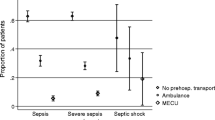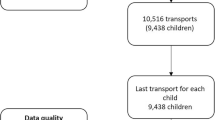Summary
Centralization of pediatric intensive care (picu) in tertiary facility centers led to a reduction in mortality and morbidity of critically ill children. In the Netherlands all eight university medical centers have picu facilities and will be able to cover national wide intensive care for children as soon as the necessary expansion of picu beds is achieved. This centralization demands a safe and well-organized interhospital pediatric intensive care transport facility accompanied by specialist retrieval teams from the picus. The time it takes to achieve this situation is mainly depending on the expansion of personal of the picu and ambulance services. Regionalization of pediatric intensive care and interhospital transport in these centers may provide rapid intervention on a continuous base for the whole country. Referring specialists are responsible for the emergency care from admission until the arrival of the retrieval team. In this way an optimalization of care for critically ill children in the Netherlands can and will be achieved.
Samenvatting
Centralisatie van pediatrische intensive care in een beperkt aantal tertiaire centra reduceert de mortaliteit en morbiditeit van kritisch zieke kinderen. In Nederland beschikken alle acht academische centra over een pediatrische intensive care-afdeling en deze kunnen geheel Nederland verzorgen zodra de uitbreiding van de picu's is bereikt. De centralisatie van de pediatrische intensive care in tertiaire centra vereist een veilig en goed georganiseerd ic-transport met begeleiding door specialistische teams vanuit de pediatrische ic-afdelingen. Door regionalisatie vanuit de bestaande tertiaire centra kan een snelle inzet van deze teams op een continue basis gerealiseerd worden. Het tijdstip waarop deze situatie kan worden bereikt hangt af van personele uitbreiding van de picu's en de ambulancediensten. De verwijzend specialist blijft verantwoordelijk voor een adequate eerste opvang van de patiënt tot deze wordt overgenomen door het transportteam na aankomst in het verwijzend ziekenhuis. Op deze wijze is het mogelijk om in Nederland een optimale zorg te verlenen aan alle kritisch zieke kinderen.

Similar content being viewed by others
Literatuur
Pollack MM, Alexander SR, Clarke N, et al. Improved outcomes from tertiary center pediatric intensive care: a statewide comparison of tertiary and nontertiary care facilities. Crit Care Med 1991;19:150-9.
Pearson G, Shann F, Barry P, et al. Should paediatric intensive care be centralised? Trent versus Victoria. Lancet 1997;349: 1213-21.
Gemke RJ, Bonsel GJ. Pediatric Intensive Care Assessment of Outcome (PICASSO) Study Group. Comparative assessment of pediatric intensive care: a national multicenter study. Crit Care Med 1995;23:238-45.
Council of the Society of Critical Care Medicine. Consensus report for regionalization of services for critically ill or injured children. Crit Care Med 2000;28:236-9.
Pediatric Section Task Force on Admission and Discharge Criteria, Society of Critical Care Medicine in conjunction with the American College of Critical Care Medicine and the Committee on Hospital Care of the American Academy of Pediatrics. Guidelines for developing admission and discharge policies for the pediatric intensive care unit. Crit Care Med 1999;27:843-5.
Guidelines for the transfer of critically ill patients. Crit Care Med 1993;21:931-7.
Ouden AL den. Pediatric intensive care in the Netherlands, inquiry report of the Inspector of Health Care. 2001,www.igz.nl.
Beleidsvisie pediatrische intensive care units van het ministerie van VWS. 2002.
Vos GD, Ramsay G. Interhospital pediatric intensive care transport. In: Vincent JL, ed. Yearbook of intensive care and emergency medicine. Berlin: Springer, 2003. p. 791-9.
Barry PW, Ralston C. Adverse events occurring during interhospital transfer of the critically ill. Arch Dis Child 1994;71:8-11.
Britto J, Nadel S, Maconochie I, et al. Morbidity and severity of illness during interhospital transfer: impact of a specialised paediatric retrieval team. BMJ 1995;311:836-9.
Macnab AJ. Optimal escort for interhospital transport of pediatric emergencies. J Trauma 1991;31:205-9.
Rashid A, Bhuta T, Berry A. A regionalised transport service, the way ahead? Arch Dis Child 1999;80:488-92.
Bleeker JK, Rutten FL, Leeuwen FL van, et al. The quality of ambulance transportation between regional hospitals and a central hospital. Ned Tijdschr Geneeskd 1993;137:1091-5.
Vos GD, Nissen A, Nieman FHM, et al. Comparison of the interhospital pediatric intensive care transport in the Netherlands accompanied by the referring specialists with a specialist retrieval team. Intensive Care Med 2004;30:302-9.
Vos GD, Nieman FHM, Meurs AMB, et al. Problems in interhospital pediatric intensive care transport in the Netherlands: results from a survey of general pediatricians. Intensive Care Med 2003;29:1555-9.
Vos GD, Buurman WA, Waardenburg DA van, et al. Interhospital pediatric intensive care transport: a novel mobile pediatric intensive care transport unit based on a standard ambulance trolley. Eur J Emerg Med 2003;10:195-9.
Advanced Life Support Group. Advanced Paediatric Life Support: The practical approach, 3rd ed. London: BMJ Books, 2001.
Author information
Authors and Affiliations
Corresponding author
Additional information
Dr. G.D. Vos, kinderarts-intensivist, Pediatrische Intensive Care, Capaciteitsgroep Kindergeneeskunde, Academisch Ziekenhuis Maastricht. J.A.K. Peper, anesthesioloog-intensivist, afdeling Intensive Care Kinderen, Emma Kinderziekenhuis AMC, Amsterdam.
Correspondentieadres: G.D. Vos, Capaciteitsgroep Kindergeneeskunde, Academisch Ziekenhuis Maastricht, Postbus 5800, 6202 AZ Maastricht, tel: 043-3875245, fax: 043-3875246.
Rights and permissions
About this article
Cite this article
Vos, G.D., Peper, J.A.K. Centralisatie van pediatrische intensive care en interklinisch pediatrisch ic-transport. KIND 72, 163–168 (2004). https://doi.org/10.1007/BF03061508
Issue Date:
DOI: https://doi.org/10.1007/BF03061508




